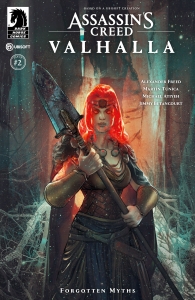Indie Comics Review: ASSASSIN’S CREED VALHALLA: FORGOTTEN MYTHS #2

[Editor’s Note: This review may contain spoilers]
Writer: Alexander M. Freed
Artist: Martin Tunica
Colors: Michael Atiyeh
Letters: Jimmy Betancourt
Publisher: Dark Horse Comics
Reviewed By: Derek McNeil
Summary
Assassin’s Creed Valhalla: Forgotten Myths #2: As the fire giants of Muspelheim rumble about war, Baldr and Loki brave immense peril and adventure to seek out rare items to gift the Muspel princess, Eysa. If Baldr can win her heart, perhaps there can be peace amongst the nine realms once more.
Positives
Assassin’s Creed Valhalla: Forgotten Myths #2 begins with Baldr attempting to enter Muspelheim in his quest to woo Eysa, the daughter of the fire demon Surtr. Baldr refused entry to Muspelheim, as he has been multiple times before. But Baldr decides to try again, but this time, he will bring a gift that cannot be turned away: a crown designed by dwarves with unmeltable ice as jewels.
Loki is generally seen as a villain, however his portrayal in Assassin’s Creed Valhalla implies that he’s a more complex character than his usual portrayal. In this series, we see that Baldr’s presence seems to bring out the better side of Loki. Loki risks his own life to assist and defend Baldr, when he could have easily left him to his own devices. It appears as if Loki actually has some affection for his nephew.
Baldr also challenges convinces Loki to win the assistance of the dwarves without lying. Loki recognizes this as an appeal to his vanity, but chooses to rise to the challenge anyway. Clearly, the heroic Baldr is exerting a good influence on the trickster god.
It’s not enough to overcome Loki’s worst nature entirely, and there’s a hint of this when Baldr reveals to Loki the secret that his sole weakness is the poison in mistle-berry (i.e. the berry of a mistletoe plant). Anyone with even a vague familiarity with Norse myth should already know what Loki will do with that information.
Also, when the crown is completed, Loki is charged with delivering the gift ahead of Baldr’s approach to Muspelheim. However, Loki instead throws the crown into lava. Then laughs at his own actions.

Positives Cont.
It seems to me that Loki, as a trickster god embodies chaos. He’s not really good or evil, but he is capable of doing right or wrong actions as the whim takes him. I think he does love his nephew, but he loves stirring up trouble more. He may be an invaluable aid at times, but relying on this invites disaster. And it appears that such a disaster is about to hit Baldr.
We do get another interlude that again shows the main story being told to a group of Vikings. However, this time it’s a different person telling the story. The storyteller appears to be the adult version of the child who had been listening to the story last issue. I like how this demonstrates the story being passed on through the generations. The children of one generation grow up and retell the story to the next generation.
Also, the child is now clearly a woman, which I believe supports my guess that the child was Eivor, the protagonist of the videogame. While the main story is clearly setting up the videogame’s Dawn of Ragnarok DLC, it’s nice to see a nod towards the game’s main story as well.
I also found it interesting that one listener states they heard another version of the story where the gift was a necklace rather than a crown. This listener is transcribing the story and wants to get the details right. However, the gift is what we would nowadays call a MacGuffin. It has no intrinsic importance. Its only importance is in how it advances the story. Such details can change without affecting the underlying story. Or as Eivor puts it, “This is greater than history, monk — Not all stories are true or lies”.
I really am enjoying Martin Tunica’s artwork on this story. The art style is well suited to story’s mythological nature. There is a sense of grandeur to the story, but it also feels slightly unreal. And this fits in with the idea that this myth is neither true nor a lie.
Negatives
I can’t really find any fault with the story Freed and Tunica are giving us. It adds to the game’s story in a meaningful way. This is difficult to do, considering that the game’s story is designed to be comprehensible whether or not you read this tie-in. Even though this story isn’t essential, Freed manages to add extra depth to the overall narrative with it.

Verdict
If you enjoyed playing Assassin’s Creed Valhalla’s Dawn of Ragnarok expansion, this Forgotten Myths is a great addition to that story. But it is quite an enjoyable excursion into Norse mythology in its own right. So, even if you haven’t played the game, it’s still well worth checking out.
